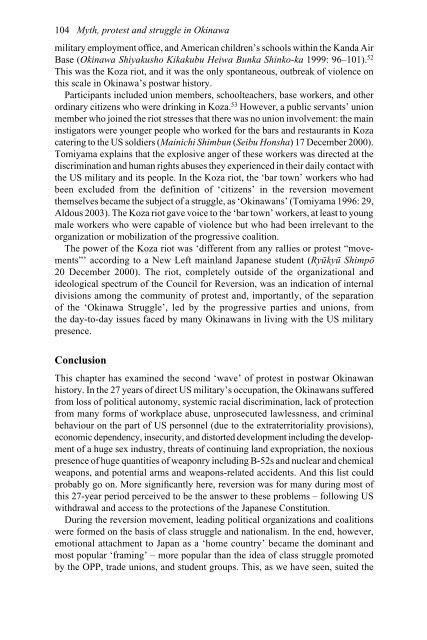Myth, Protest and Struggle in Okinawa
Myth, Protest and Struggle in Okinawa
Myth, Protest and Struggle in Okinawa
Create successful ePaper yourself
Turn your PDF publications into a flip-book with our unique Google optimized e-Paper software.
104 <strong>Myth</strong>, protest <strong>and</strong> struggle <strong>in</strong> Ok<strong>in</strong>awa<br />
military employment office, <strong>and</strong> American children’s schools with<strong>in</strong> the K<strong>and</strong>a Air<br />
Base (Ok<strong>in</strong>awa Shiyakusho Kikakubu Heiwa Bunka Sh<strong>in</strong>ko-ka 1999: 96–101). 52<br />
This was the Koza riot, <strong>and</strong> it was the only spontaneous, outbreak of violence on<br />
this scale <strong>in</strong> Ok<strong>in</strong>awa’s postwar history.<br />
Participants <strong>in</strong>cluded union members, schoolteachers, base workers, <strong>and</strong> other<br />
ord<strong>in</strong>ary citizens who were dr<strong>in</strong>k<strong>in</strong>g <strong>in</strong> Koza. 53 However, a public servants’ union<br />
member who jo<strong>in</strong>ed the riot stresses that there was no union <strong>in</strong>volvement: the ma<strong>in</strong><br />
<strong>in</strong>stigators were younger people who worked for the bars <strong>and</strong> restaurants <strong>in</strong> Koza<br />
cater<strong>in</strong>g to the US soldiers (Ma<strong>in</strong>ichi Shimbun (Seibu Honsha) 17 December 2000).<br />
Tomiyama expla<strong>in</strong>s that the explosive anger of these workers was directed at the<br />
discrim<strong>in</strong>ation <strong>and</strong> human rights abuses they experienced <strong>in</strong> their daily contact with<br />
the US military <strong>and</strong> its people. In the Koza riot, the ‘bar town’ workers who had<br />
been excluded from the def<strong>in</strong>ition of ‘citizens’ <strong>in</strong> the reversion movement<br />
themselves became the subject of a struggle, as ‘Ok<strong>in</strong>awans’ (Tomiyama 1996: 29,<br />
Aldous 2003). The Koza riot gave voice to the ‘bar town’ workers, at least to young<br />
male workers who were capable of violence but who had been irrelevant to the<br />
organization or mobilization of the progressive coalition.<br />
The power of the Koza riot was ‘different from any rallies or protest “movements”’<br />
accord<strong>in</strong>g to a New Left ma<strong>in</strong>l<strong>and</strong> Japanese student (Ryūkyū Shimpō<br />
20 December 2000). The riot, completely outside of the organizational <strong>and</strong><br />
ideological spectrum of the Council for Reversion, was an <strong>in</strong>dication of <strong>in</strong>ternal<br />
divisions among the community of protest <strong>and</strong>, importantly, of the separation<br />
of the ‘Ok<strong>in</strong>awa <strong>Struggle</strong>’, led by the progressive parties <strong>and</strong> unions, from<br />
the day-to-day issues faced by many Ok<strong>in</strong>awans <strong>in</strong> liv<strong>in</strong>g with the US military<br />
presence.<br />
Conclusion<br />
This chapter has exam<strong>in</strong>ed the second ‘wave’ of protest <strong>in</strong> postwar Ok<strong>in</strong>awan<br />
history. In the 27 years of direct US military’s occupation, the Ok<strong>in</strong>awans suffered<br />
from loss of political autonomy, systemic racial discrim<strong>in</strong>ation, lack of protection<br />
from many forms of workplace abuse, unprosecuted lawlessness, <strong>and</strong> crim<strong>in</strong>al<br />
behaviour on the part of US personnel (due to the extraterritoriality provisions),<br />
economic dependency, <strong>in</strong>security, <strong>and</strong> distorted development <strong>in</strong>clud<strong>in</strong>g the development<br />
of a huge sex <strong>in</strong>dustry, threats of cont<strong>in</strong>u<strong>in</strong>g l<strong>and</strong> expropriation, the noxious<br />
presence of huge quantities of weaponry <strong>in</strong>clud<strong>in</strong>g B-52s <strong>and</strong> nuclear <strong>and</strong> chemical<br />
weapons, <strong>and</strong> potential arms <strong>and</strong> weapons-related accidents. And this list could<br />
probably go on. More significantly here, reversion was for many dur<strong>in</strong>g most of<br />
this 27-year period perceived to be the answer to these problems – follow<strong>in</strong>g US<br />
withdrawal <strong>and</strong> access to the protections of the Japanese Constitution.<br />
Dur<strong>in</strong>g the reversion movement, lead<strong>in</strong>g political organizations <strong>and</strong> coalitions<br />
were formed on the basis of class struggle <strong>and</strong> nationalism. In the end, however,<br />
emotional attachment to Japan as a ‘home country’ became the dom<strong>in</strong>ant <strong>and</strong><br />
most popular ‘fram<strong>in</strong>g’ – more popular than the idea of class struggle promoted<br />
by the OPP, trade unions, <strong>and</strong> student groups. This, as we have seen, suited the
















